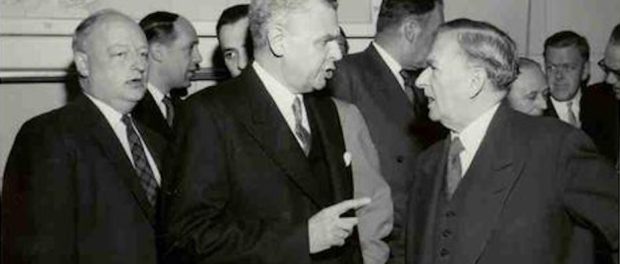1958: The Other Chief & Other Quebec Curios
Part of “Shadows and Revolution”, 1900-1960
 John Diefenbaker and Maurice Duplessis have a friendly chat. Source: University of Saskatchewan, reference code: JGD/MG01/XVII/JGD 451.
John Diefenbaker and Maurice Duplessis have a friendly chat. Source: University of Saskatchewan, reference code: JGD/MG01/XVII/JGD 451.
John Diefenbaker’s law practice that began in a shack that he had built on a vacant spot of land and ended with his competitor being run out of town. His political career began in the 1920s, resulting in his first contact with a fellow Liberal candidate, William Lyon Mackenzie King. Up against this giant of Canadian politics, Diefenbaker, then an unknown next to the Prime Minister of Canada, lost. Through the 1930s, Diefenbaker tried and failed to gain a seat in the House of Commons, only succeeding in 1940 in an election that had otherwise left the Conservatives obliterated at 39 seats out of the 245 seats then available.
Throughout Diefenbaker’s over sixty year career in law and in politics, he had many liberating ideas. His law practice included defending eighteen people from the death penalty. As a Member of Parliament, he opposed Mackenzie King’s internment of thousands of innocent Japanese Canadians in a time when racism towards this group of people was widespread and normalised and he also opposed a motion from his own home party, the Progressive Conservatives, to outlaw the Communist Party from politics. As Prime Minister, he appointed the first female Cabinet minister, appointed the first First Nations member to the Senate, and he passed the quasi-constitutional law, the Canadian Bill of Rights, which would serve as a precursor to the Canadian Charter of Rights and Freedoms. His struggle to the very top of Canadian politics, ever branded as an outsider and what was seen as his authentic and strong connection with the people he met led him to be named “the Chief”, much like Quebec Premier Maurice Duplessis. With the 1958 federal election coming up, Duplessis, who did not like Mackenzie King much anyway (the feeling was mutual), threw his support behind Diefenbaker, and the Quebec population voted in consequence.
The Progressive Conservative party won 208 seats of the 265 seats that then composed the House of Commons (78% of the House) and roughly 54% of the popular vote, making John Diefenbaker’s election remains the largest majority government in Canadian history, surpassed in number but not in percentages by Conservative Brian Mulroney’s win in 1984. Once in power, he made clear that his vision was in direct opposition to Duplessis, and he expressed it with two words: One Canada.
As a young man growing up in Saskatoon, Saskatchewan, Diefenbaker had been in contact with the minorities of the province, the Métis and the Francophone Canadians in particular. Diefenbaker’s “One Canada” policy envisioned total equality for all and between all provinces, from coast to coast, and he believed that everybody should have an equal standing within the country. This equality was absolute, where exceptions were not given and the notion of two nations within Canada and the concept of Quebec as different from the other provinces were all but quashed out of a Canadian identity. For Diefenbaker, everyone was Canadian and Canada was a dream worth believing in—but Quebec in particular was being rather difficult in achieving this dream. For Quebec to have its own flag and its own taxes, seen as a refusal to be part of this “One Canada”, was sacrilege.
Quebec’s support for Diefenbaker and the Conservatives waned in consequence and the Quebec population turned instead towards Lester B. Pearson’s Liberals. In the next federal election, Diefenbaker’s Conservatives won a measly 14 seats in Quebec compared to the over thirty seats for Lester B. Pearson’s Liberals.





